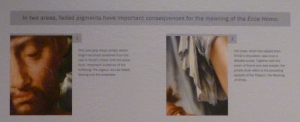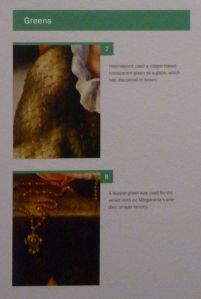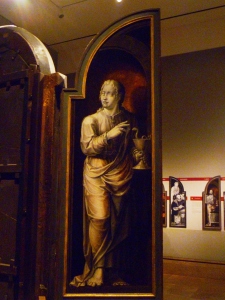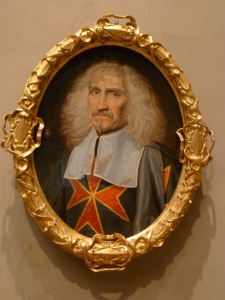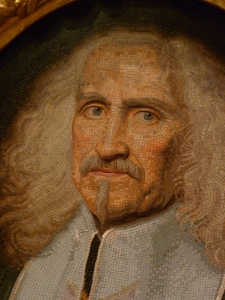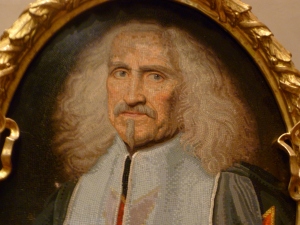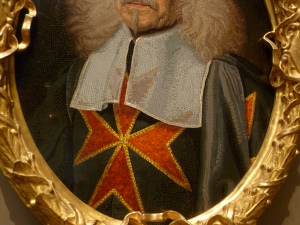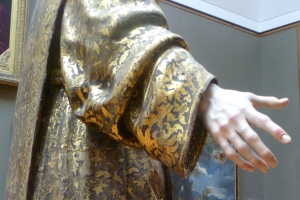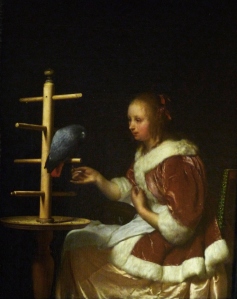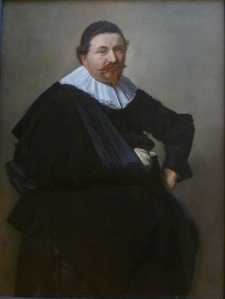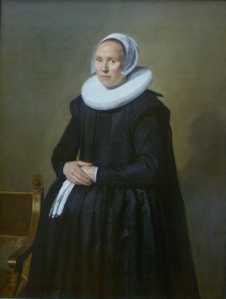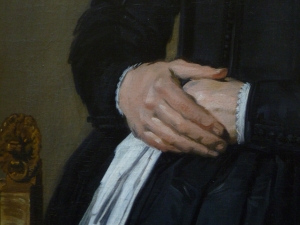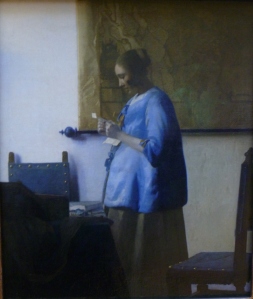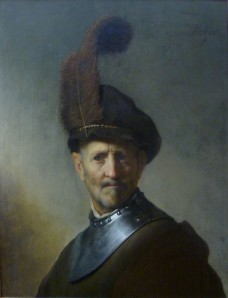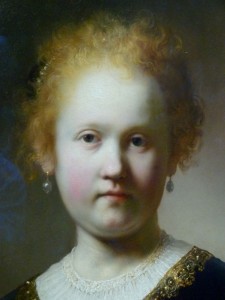On our trip to the de Young and Getty museums last week, we took photos of paintings wherever possible. Of course I know it’s difficult for photography to capture the true essence of paintings and their myriad nuances of colors and values, but now I really know it. There aren’t many paintings like Girl with a Pearl Earring with which I have such intimacy, so arriving at a more complete understanding of this was a kind of epiphany for me.
During the painting’s latest restoration (1994), they discovered that Vermeer’s original background had a dark green enamel-like surface, accomplished through the application of glazes. However, the pigments available to him faded so much over 350 years, that the background looked blackish. This was corrected by the restorers and now, you can almost see the brushstrokes of the slightly sketchy transparent earthy-green glaze applied over the dark background underpainting.
Here is a photo of a high-quality postcard I bought, since the de Young did not allow photos of the special exhibit on loan from the Mauritshuis, particularly of the “Dutch Mona Lisa,” as she is called. They had her under guard at all times. Although a photo doesn’t pick up on the background color that well, can you see the slightest hint of green?

And here is a photo of the installation of Vermeer’s Woman in Blue Reading a Letter. Look at how the line curves where the floor and wall meet–this is an excellent example of barrel lens distortion:
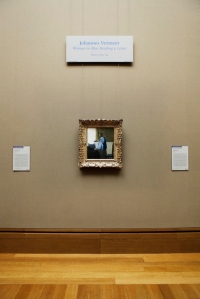
And on the subject of picture taking, what photography can and cannot do has been discussed and written about ad infinitum, so I won’t go into it much here other than to say that if you are painting from photographs, a solid understanding of the way the camera plays tricks on you is essential. Certainly it matters the quality of camera and lens you use. However, beyond that, you must be aware of how all cameras visually distort images, and then make adjustments in the painting you create from these photos.
For example, make sure to adjust your composition to account for the camera’s barrel distortion (convex lines), pincushion distortion (concave lines), flattening; and adjust for the fact that reds will “read” much darker in value than they really were when you took the photo. You can make these changes right on you drawing, or they can be adjusted in Photoshop first. We all love what cameras do for us, but be aware that edges will appear sharper and you will have to soften them in your painting to create recession in your work. As Frank Covino always teaches, “Don’t gray the shadows; gray the shadow’s edges.” You must soften edges where you want to round your images and make them appear recessional.
You can always tell when someone paints from photos and is unaware of flattening, for instance. The subject’s hands or feet will appear larger than they are in real life, and out of proportion with the rest of the figure, because hands or feet are typically in front of the figure. You must know this and make them proportionately smaller in your drawing to compensate and adjust sizes to their correct proportions. In other words, don’t make the hands as big as the head, even though they may appear that way in the photo.
You can find out more about the subject of camera distortion at this excellent site: http://www.kenrockwell.com/index.htm
Also, James Gurney at http://www.gurneyjourney.blogspot.com (the famous creator of Dinotopia) has provided an ongoing and wonderfully thorough exploration into how we humans see.
Something that struck me about these exhibits were that, no matter how much impasto the artist used, they began with the smoothest of canvases or boards. I looked up at various angles and marveled at how perfectly prepared they were. I can never seem to get mine that smooth but I continue to search for the trick to it.
Another thing that surprised me was Girl with a Pearl Earring‘s eye color; they are not light golden brown, or blue, or green, or gray. They are gray-blue with the absolute slightest hint of light golden brown, so difficult to describe. I stood there trying to figure out how he accomplished that and if I were trying to duplicate that color without causing the eyes to become greenish, I would paint them gray-blue first, let them dry completely, and then ever so gently, glaze just a small part of the reflected light area of the iris with a golden brown glaze. I still can’t imagine how Vermeer really did it, but that would be how I would approach it.
Below are some other photos (including 2 closeups) I took that you might enjoy:
A Banquet Piece, About 1630, Pieter Claesz, Dutch, 1596/97-1660, Oil on panel
“A shaft of light from an unseen window poetically illuminates the textures and surfaces of a few objects on a stone ledge. This type of still life, known as a “monochrome banquet piece” for its harmonious though limited palette of browns and grays, was an artful invention intended to astonish the viewer with its beauty rather than a portrayal of an actual meal. Imported items such as a peeled lemon and the overturned Venetian-style glass contrast with local oysters and the monumental Dutch drinking glass with a textured stem. Claesz’s nuanced rendering reveals his interest in optical effects, such as the reflected windowpanes and the fall of light across the luminous lemon rind.” de Young Museum
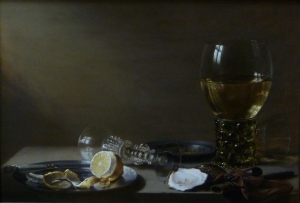

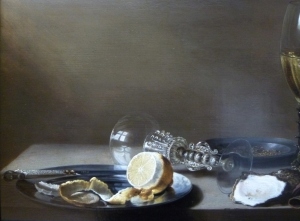
Mars and Venus Surprised by Vulcan, About 1606-10, Joachim Wtewael, Dutch, 1566-1638, Oil on copper
“Here the blacksmith god Vulcan pulls back the fine metal net in which he has trapped his wife, Venus, and her lover, Mars, exposing them to the laughter of their fellow gods. Like other Mannerist painters, Wtewael delighted in complexity and paradox. In this work he presents heroic figures on a tiny scale and Olympian gods in a compromising situation.”

I had to take this photo through a glass case. I have been experimenting with painting on copper as many of the Old Masters did so, and saw the paintings on copper exhibit at the Phoenix Art Museum many years ago. They are exquisite to this day, with no craquelure. Experts attribute this to the fact that copper expands and contracts at approximately the same rate and temperature as does traditional oil paint.
Note: All text in quotes is taken from the Getty or de Young museum placards posted beside paintings.









